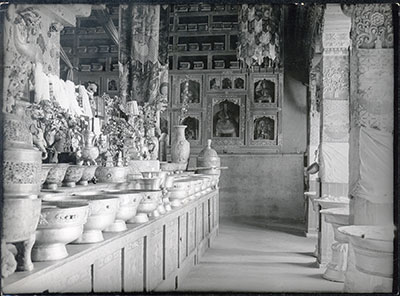
1998.131.308 (Print black & white)


1998.131.308 (Print black & white)

Frederick Spencer Chapman
Frederick Spencer Chapman
September 6th 1936
Lhasa > Potala > 13th Dalai Lama's tomb
1998.131.308
126 x 172 mm
Print gelatin silver
Donated 1994
Faith Spencer Chapman
British Diplomatic Mission to Lhasa 1936-37
Frederick Spencer Chapman
C.14.3 In publication
'Lhasa Mission 1936, Diary of Events', P. Neame, H. Richardson, F. S. Chapman, Government of India Political Department [Note: photographs for October 18th - November 4th 1936 are not included as their relationship to text is not detailed; see Mission Diary text for details of images] [see photos in publication]
SC.T.2.308
BMR.86.1.45.4
'Lhasa Mission 1936, Diary of Events', P. Neame, H. Richardson, F. S. Chapman, Government of India Political Department [Note: photographs for October 18th - November 4th 1936 are not included as their relationship to text is not detailed; see Mission Diary text for details of images] [view list of illustrations]
Notes on print/mount - The back of the print is covered in crop and reproduction markings. These incluse the instruction 'Cut as shown and reduce to 5 5/8" across', a size that seems to have been employed for images used in the official photograph album of the British Mission to Lhasa in 1936-7. Significant reference numbers include 'C/14/3', which relates to the numbering system that Chapman adopted for images taken whilst on the mission, and the Chatto & Windus publisher reference '41298/15'. The number '43a' has been written in pencil in the top left hand corner. [MS 8/4/2005]
Manual Catalogues - Caption in Chapman's hand-written list of negatives made whilst on the Mission to Lhasa, 1936-7 [See PRM Manuscripts Collection]: 'Looking down front of D.L.’s tomb v.g.'; PRM Manuscripts Collection: ‘List of Tibetan Prints and Negatives’ - Book 2: ‘6/2 - Gifts from all parts of the Buddhist world on shrine of last Dalai Lama’ [MS 18/03/2006]
Contemporary Publication - This image was used to illustrate the Mission Diary of the British Mission to Lhasa in 1936-7 for the day of November 22nd 1936. On this day, members of the Mission made a return visit to the Potala Palace: "As Gould was ill, and Nepean and Dagg had not yet reached Lhasa, when we first visited the Potala [on September 6th 1936], we arranged another visit for today. // The Potala defies description. ... whether you climb one of its many flights of stone steps, and thread you [sic] way up dark, slippery staircases eventually to reach the lavishly bejewelled shrine of the last and greatest Dalai Lama, you cannot fail to be impressed, not only by its unique character, but by its sheer immensity" [MS 8/4/2005]
Other Information - Related Images: Images prefixed with 'C.14 comprise a group of negatives containing images of the 13th Dalai Lama’s tomb and views around the Potala. They were all taken on the Mission party's first official visit to the Potala on September 6th 1936 [MS 18/03/2006]
Other Information - Description: Chapman wrote a relatively extensive description of this tomb and the structural alterations that its construction had necessitated upon the Potala itself in his book Lhasa the Holy City [London: Chatto & Windus, 1938; reprinted London: Readers Union Ltd., 1940]. Chapman wrote: "The main chorten is encased in gold embossed with different designs and plentifully encrusted with precious stones. In some places valuable charm boxes, turquoise ear-rings, onyx and coral snuff-boxes, strings of amber and pearls, and innumerable unset gems have been let in to form designs on the gold background. On several shelves in front are displayed more precious presents, gifts from the ancient and noble families of Tibet and from the rich monasteries of China and Mongolia. Here are rare porcelain vases, exquisite examples of cloisonne work, chalice-like vessels of solid gold, meticulously wrought metal-work, alabaster models of temples, and glass cases containing curiously fashioned flowers with leaves and petals of china. On the eastern wall of the room are pigeon-holes containing holy books with carved wooden covers, many small images, and filigree charm-boxes such as are carried by travellers. // In front of the shrine burn several enormous butter-lamps of solid silver. They stand four feet high, and the bowls, with a tow of burning wicks floating in the fat, are more than two feet in diameter. Each wick has melted a little lake for itself in the congealed butter. White scarves had been thrown up on to the chorten by pilgrims, and there were vases of artificial and real flowers in different parts of the shrine, while the square wooden pillars surrounding the tomb and supporting the roof are covered by long brocade strips of different colours, each hanging over the next like the scales of a fish. Although certain details of the tomb, such as teh crystal globes hanging from the ceiling and a coloured biscuit-tin on one of the shelves, struck a false note, the general impression is a fitting tribute to the memory of this revered ruler" [1940, pp. 179-80] [MS 11/4/2005]
For Citation use:
The Tibet Album.
"13th Dalai Lama's tomb, Potala"
05 Dec. 2006. The Pitt Rivers Museum.
<http://tibet.prm.ox.ac.uk/photo_1998.131.308.html>.
For more information about photographic usage or to order prints, please visit the The Pitt Rivers Museum.
© The Pitt Rivers Museum